Watermelon Tuna is watermelon that’s marinated and baked in a savory brine that really makes it taste like sashimi-style vegan ahi tuna! It’s tender and luscious, not at all like the watery sweet fruit everyone knows. Give it a try!
Jump to:

This post may contain affiliate links. See our disclosure policy for details.
Hey Internet, when I first heard of people marinating and baking watermelon to taste like meat (I’ve primarily seen steak), I was completely skeptical. But after trying some delicious tomato-based tuna at my favorite vegan-friendly sushi restaurant, I wanted to try making vegan watermelon tuna.
I’m no stranger to making vegan seafood, such as my recent tofu salmon, vegan ceviche, vegan tuna casserole, vegan scallops, vegan lobster roll, vegan fish tacos, and vegan tuna melt. I’m even working on a recipe for vegan shrimp (coming soon!).
This vegan ahi tuna stuff is absolutely incredible. It does not have the taste or texture of watermelon, at all. It really does taste like the sashimi style tuna I used to love before I went vegan.
I’m sharing my two favorite ways to eat it: as vegan sashimi (on top of sushi rice), and as a vegan tuna poke bowl.
Of course I already have a tofu poke bowl recipe, so the bowl looks pretty similar, only with this fancy vegan tuna as the star of the show.
But this stuff would also be great on crackers or rice cakes, or mixed with some vegan cream cheese as a fun dip. Or add it to a salad.
Why This Recipe Works
I know this sounds absolutely nuts. I admit I was pretty skeptical.
But it’s mind blowing.
So watermelon--it’s sweet, it’s kinda crunchy, and it’s pretty watery.
But watermelon tuna… it’s tender and flexible, savory, salty, and “fresh” tasting--as in it tastes a whole lot like sashimi.
First, the watermelon gets cubed or thinly sliced--keep in mind, it does shrink a little during the baking process.
After that, it gets marinated for 3-4 hours in a salty and umami marinade that has a fairly short ingredients list including things like soy sauce and toasted sesame oil.
Finally, the watermelon is drained and baked in the oven for around 45 minutes to an hour depending on how thinly it is sliced.
And that’s it! It tastes better at room temperature or cold so I let it cool before using it.
I took one watermelon and used it to make a vegan tuna poke bowl (actually we got about 4 of these over the course of a few days), many vegan nigiri, and even a vegan sushi burrito (x2!)!
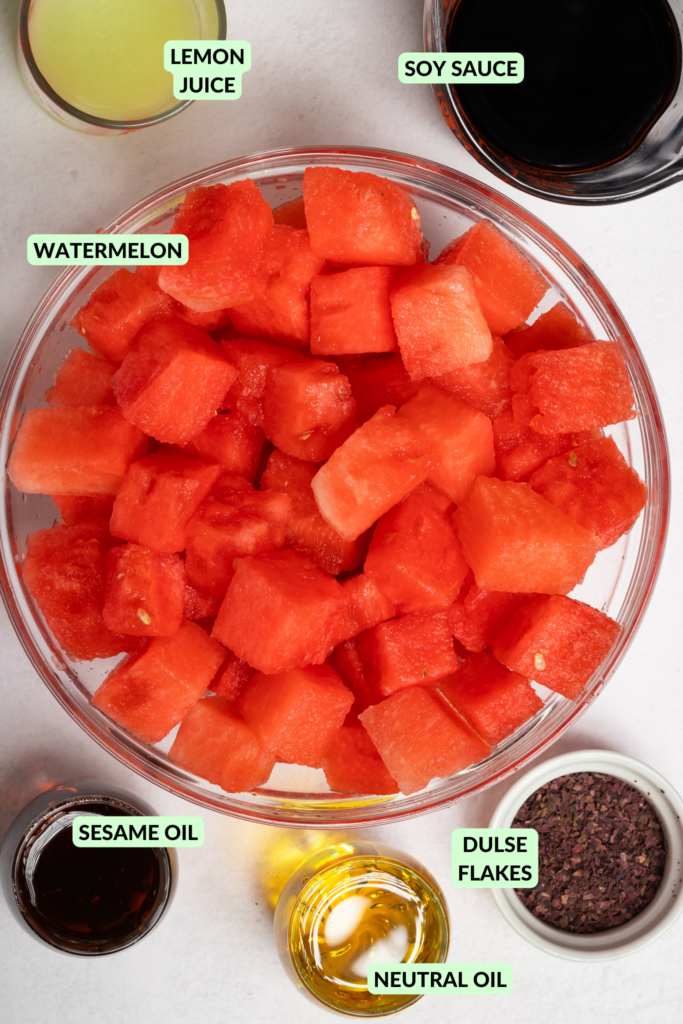
Ingredients and Notes
- Watermelon: This is watermelon tuna, so you’ll need watermelon and I don’t have a replacement for that because otherwise the method would be different. To go along with the marinade, you’ll need about half of a large seedless watermelon, or about 6-7 cups fresh seedless watermelon. It doesn’t really matter if the watermelon is sweet or not, it will get plenty of flavoring from the marinade.
- Reduced sodium soy sauce: This is necessary but if you are gluten-free, just use a gluten-free tamari. It’s not imperative for it to be reduced sodium--the regular version is too salty for our taste buds. If you only have regular soy sauce available, I’d try diluting it by one third the amount of water.
- Toasted sesame oil: This really helps flavor the dish so I don’t recommend skipping it. If you can only find regular sesame oil, that’s OK, but it tastes better to use toasted or roasted sesame oil, so use that if you can find it (I usually get mine at Trader Joe’s or my local grocery store).
- Neutral oil of choice: We need a decent amount of oil to transform the texture of the watermelon. However, using all sesame oil is not only expensive, but I think the flavor would get too strong. So instead, I recommend using half sesame oil, half neutral flavored oil of your choice. I used avocado oil but other good options are grapeseed oil, safflower seed oil, or even vegetable oil will work.
- Lemon juice: Fresh squeezed lemon juice will give us a little of that seafood “tang” we’re looking for. I highly recommend fresh over bottled.
- Dulse flakes, optional: Finally, for a little “fishy” flavor (but it’s not strong at all), I used a small amount of dulse flakes which I purchased online. You can substitute kelp granules or even a ripped up sheet of nori or two. Rip into tiny pieces and mix with the marinade.


How to Make Watermelon Tuna
- Start by slicing up your watermelon. I recommend using a seedless watermelon. Slice or chop the watermelon depending on what size and shape watermelon tuna you want. I like to dice it in 1 - 1 ½ inch cubes for a vegan tuna poke bowl, or in 1 ½ inch by 3 inch (ish) slabs (about ½ inch thick) for vegan nigiri. You could even do a mix of both. Either way, you’ll need about 6 or 7 cups of watermelon. Keep in mind that the watermelon does shrink a little during the baking process.
- In a small bowl or measuring cup (I like to use a measuring cup since it has a spout), mix together the soy sauce, or gluten-free tamari, toasted sesame oil, neutral oil, fresh squeezed lemon juice, and the optional dulse flakes.
- Add the watermelon to a wide container. The wider the better because then the watermelon can spread out and get evenly coated with the marinade. Pour the marinade on top and mix gently. Cover and marinate for 3-4 hours. You can get away with as little as 2 hours or as many as 6 hours. After that the watermelon starts to deteriorate a bit.
- After marinating, preheat the oven to 375 degrees Fahrenheit (190 degrees Celsius) and strain out the liquid (you can reuse this later if you’d like--it would also make a great tofu marinade if you wanted to prepare meals for the week!) and add the watermelon to a lined baking sheet in a single layer. Let each piece have a little space in between (around ½ an inch or more).
- Bake for 40-60 minutes--it kind of depends on how thinly you cut it! It should be a little darker, smaller, and it will be more tender when it’s done. I recommend letting it cool before serving--it tastes better at room temperature or chilled. It will soften a little in the fridge, though, so my favorite time to serve it is when it has just cooled to room temperature.
- Serve as you’d like--in a poke bowl or a sushi bowl, in sushi burrito, in onigirazu (like a sushi sandwich), in vegan tuna sushi rolls (try making a spicy mayo from vegan mayo and sriracha), on top of rice as nigiri, etc. If you want to make the nigiri, watch a video online on how to shape it--that’s what I did, but I’m definitely not good enough at it to write instructions.
- Refrigerate leftover watermelon tuna for up to 2-3 days in an airtight container. The texture softens a little in the fridge but it still tastes good for a few days afterword. Great in bowls!
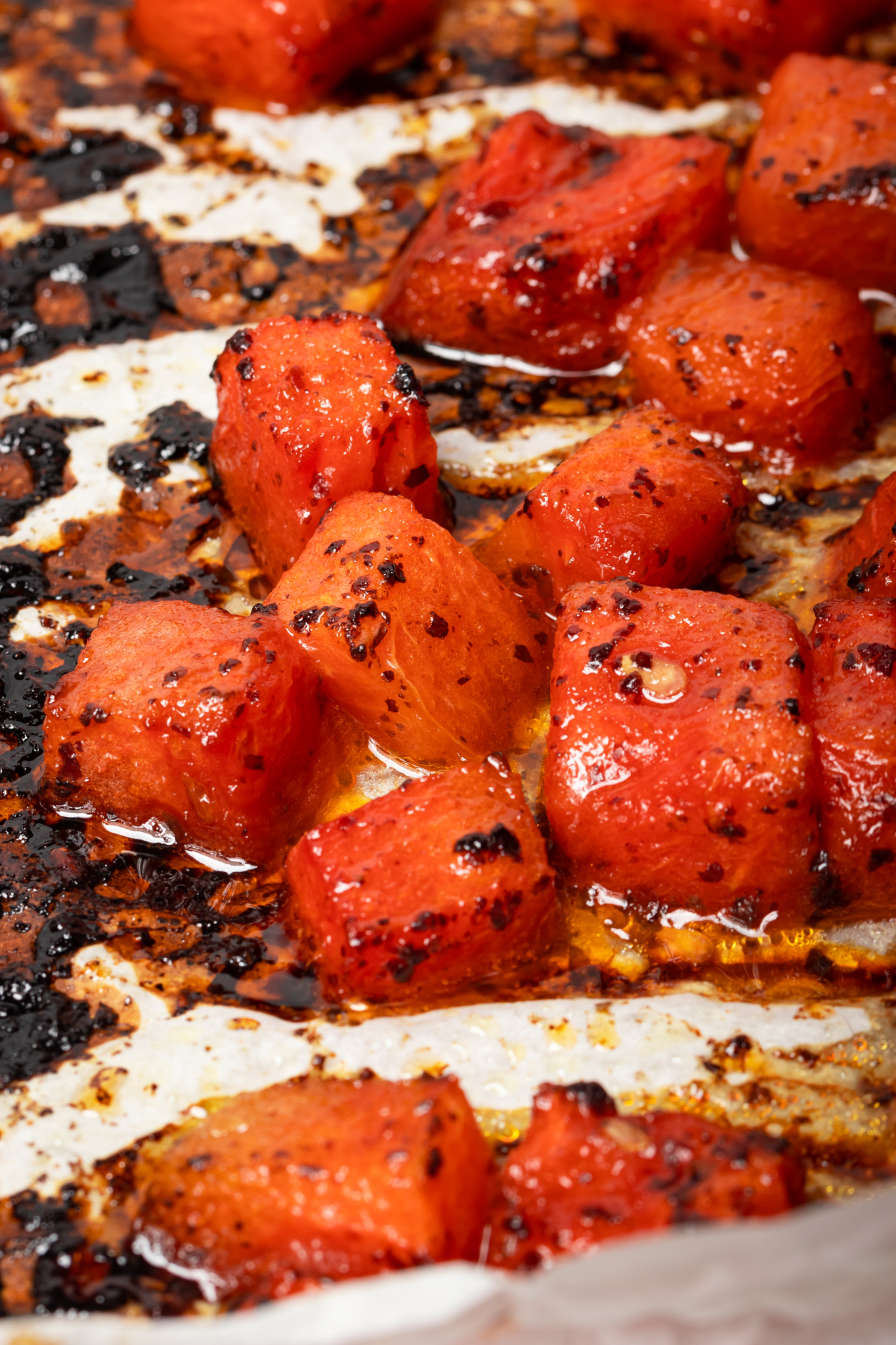
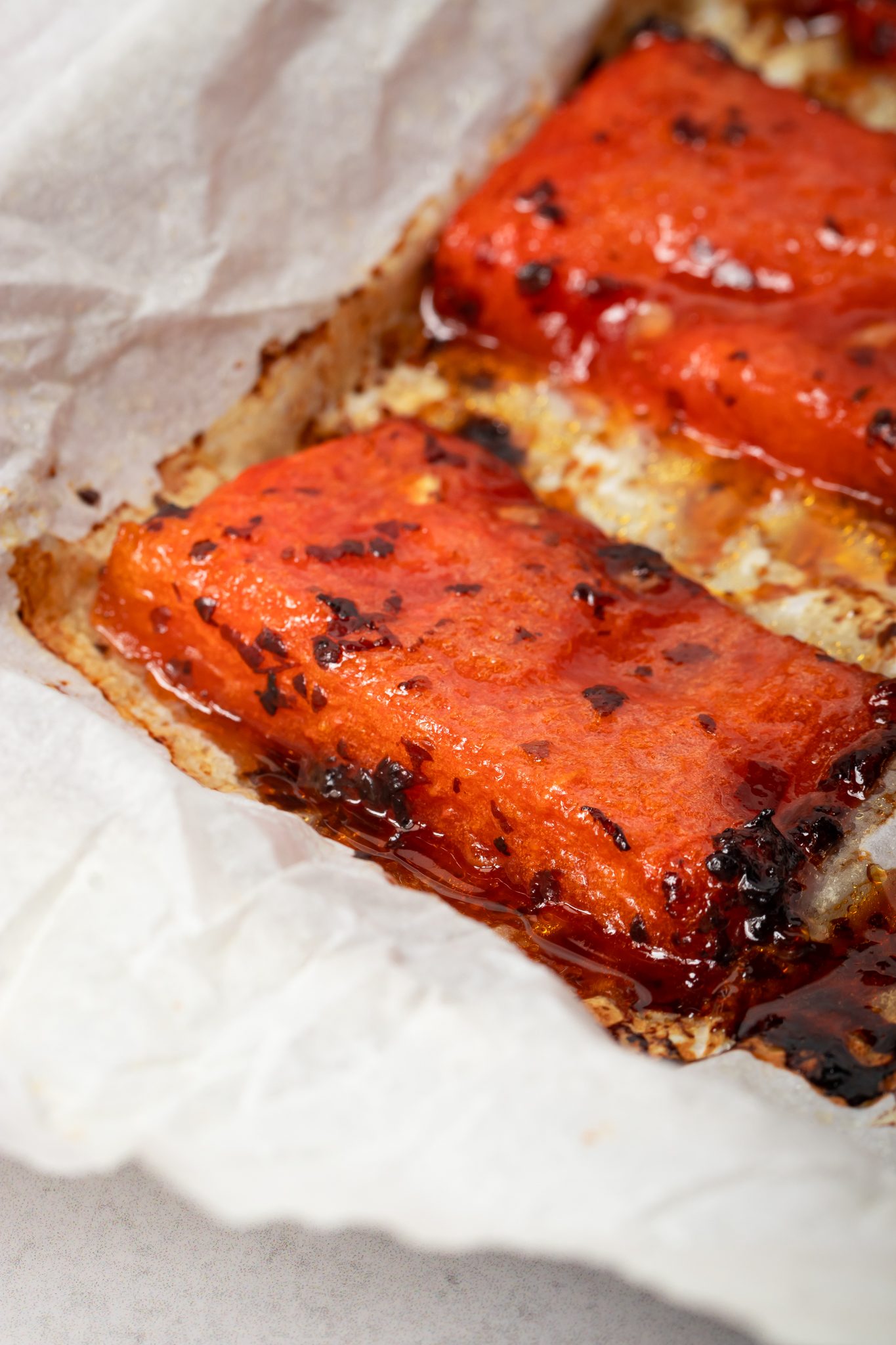
Frequently Asked Questions
It’s easy to make a poke bowl. It’s basically just a base of rice and a variety of toppings. I like to use cucumber, shredded or grated carrots, edamame, green onion, mango or pineapple, avocado, pickled ginger, toasted sesame seeds, etc. If you want more info, check out my tofu poke bowl recipe.
If you want to make vegan tuna sushi or nigiri, I recommend cutting the watermelon in small slabs or strips and baking 40-50 minutes after the marination process. Make some sushi rice and add vinegar, sugar, and salt -- let cool for about 1 hour and then it’s perfect for sushi use. For shaping and technique, I highly recommend watching some videos online. I have done this a little… but I don’t feel confident enough to instruct anyone on creating their own sushi or nigiri.
This is a very easy meal using components from the poke bowl. I like to lay a thin layer of cooked sushi rice (leave an inch at the top with no rice) on a sheet of nori (seaweed for sushi), and then add toasted sesame seeds, grated carrots, cucumbers, green onions, the watermelon tuna, avocado, and a good squeeze of vegan spicy mayo (vegan mayo + sriracha). Then wet the bare strip of nori at the top, roll up and seal. Wrap in paper, wet your sharpest knife, and cut on the diagonal. Serve with some soy sauce for dipping and anything else you like such as wasabi or pickled ginger.
I recommend storing leftover vegan ahi tuna in an airtight container--I think glass is best--for about 2-3 days. It does get a little softer in the fridge but it still tastes great.
Expert Tips for Best Results
- To make this gluten-free, just use gluten-free tamari or a gluten-free soy sauce alternative.
- Don’t cut the watermelon too small, it does shrink a bit when it bakes.
- If you want it to taste like seafood, don’t skip the dulse flakes (or you can use shredded / ripped nori sheets or kelp granules)! It might look a little funky but they flavor the watermelon tuna a lot.
- It tastes even better when it’s in something, like a poke bowl or sushi, so have a plan and some ingredients ready!
More Recipes Like This
I’m creating quite a collection of vegan seafood recipes! Here’s my budding collection:
- Vegan Scallops
- Vegan Paella
- Vegan Fish Tacos
- Vegan Lobster Roll
- Tofu Salmon
- Vegan Tuna Casserole
- Vegan Tuna Melt
- And Vegan Ceviche
Never miss a recipe! Join my mailing list to receive a free copy of my e-book on my go-to plant based recipes as well as vegan tips, NEW recipes straight to your inbox. I promise to NEVER spam you or sell your information.
Follow me on Instagram, Facebook, TikTok, Pinterest, or YouTube for more vegan tips, recipes, and to see all my recipe videos (I even have recipes not on the blog!).
Finally, did you know I have books? Visit my shop page to see the various e-books (even a print book!) I have available. My best seller is Plant-Based Jewish Recipes, and I’m in the middle of a second volume of that as well as a new book in the works that focuses on one of my favorite gluten-free vegan proteins.
<3 Liz
Save this for later on Pinterest!
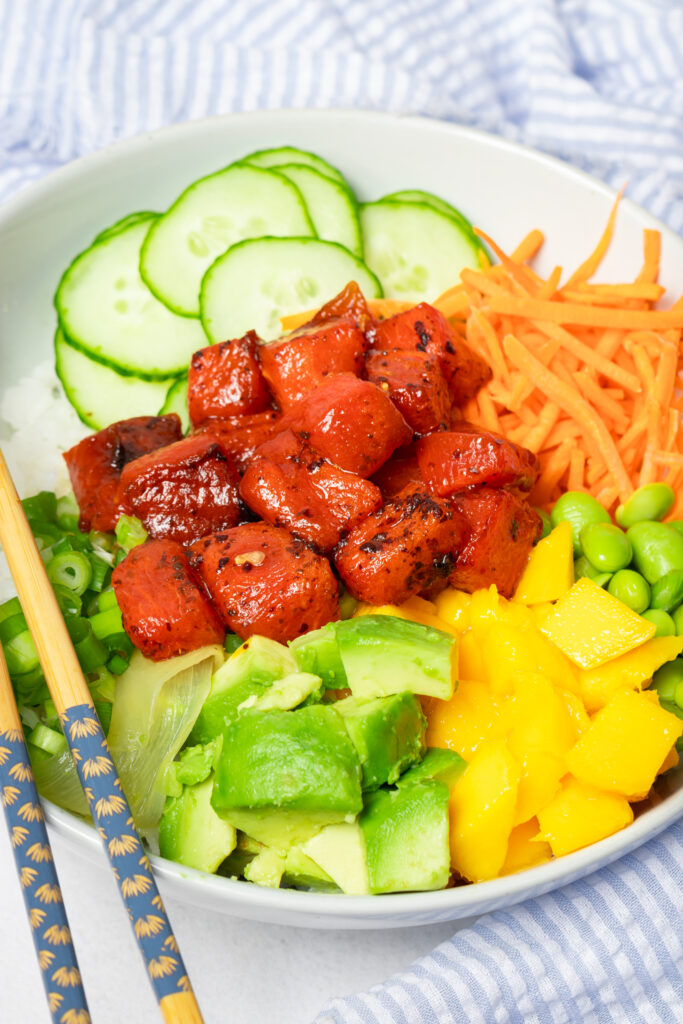

Watermelon Tuna
- Total Time: 2 hours, 50 minutes
- Yield: 4 cups 1x
- Diet: Vegan
Description
Watermelon Tuna is watermelon that’s marinated and baked in a savory brine that really makes it taste like sashimi-style vegan ahi tuna!
Ingredients
- 6-7 cups seedless watermelon, diced or sliced (see 1st step for cutting suggestions)
- ½ cup reduced sodium soy sauce or gluten-free tamari (if GF)
- 3 tablespoons toasted sesame oil (see note 1)
- 3 tablespoons neutral oil like avocado oil (see note 2)
- ⅓ cup fresh squeezed lemon juice
- 1 tablespoon dulse flakes, optional (see note 3)
Instructions
- Start by slicing up your watermelon: I recommend using a seedless watermelon. Slice or chop the watermelon depending on what size and shape watermelon tuna you want. I like to dice it in 1 - 1 ½ inch cubes for a vegan tuna poke bowl, or in 1 ½ inch by 3 inch (ish) slabs (about ½ inch thick) for vegan nigiri. You could even do a mix of both. Either way, you’ll need about 6 or 7 cups of watermelon. Keep in mind that the watermelon does shrink a little during the baking process.
- Make the marinade: In a small bowl or measuring cup (I like to use a measuring cup since it has a spout), mix together the soy sauce, or gluten-free tamari, toasted sesame oil, neutral oil, fresh squeezed lemon juice, and the optional dulse flakes.
- Mix marinade with watermelon: Add the watermelon to a wide container. The wider the better because then the watermelon can spread out and get evenly coated with the marinade. Pour the marinade on top and mix gently. Cover and marinate for 3-4 hours. You can get away with as little as 2 hours or as many as 6 hours. After that the watermelon starts to deteriorate a bit.
- Prep for baking: After marinating, preheat the oven to 375 degrees Fahrenheit (190 degrees Celsius) and strain out the liquid (you can reuse this later if you’d like--it would also make a great tofu marinade if you wanted to prepare meals for the week!) and add the watermelon to a lined baking sheet in a single layer. Let each piece have a little space in between (around ½ an inch or more).
- Bake: Bake for 40-60 minutes--it kind of depends on how thinly you cut it! It should be a little darker, smaller, and it will be more tender when it’s done. I recommend letting it cool before serving--it tastes better at room temperature or chilled. It will soften a little in the fridge, though, so my favorite time to serve it is when it has just cooled to room temperature.
- Serve as desired: Serve as you’d like--in a poke bowl or a sushi bowl, in sushi burrito, in onigirazu (like a sushi sandwich), in vegan tuna sushi rolls (try making a spicy mayo from vegan mayo and sriracha), on top of rice as nigiri, etc. If you want to make the nigiri, watch a video online on how to shape it--that’s what I did, but I’m definitely not good enough at it to write instructions.
- Store: Refrigerate leftover watermelon tuna for up to 2-3 days in an airtight container. The texture softens a little in the fridge but it still tastes good for a few days afterword. Great in bowls!
Notes
- Note 1: Toasted sesame oil really helps flavor the dish so I don’t recommend skipping it. If you can only find regular sesame oil, that’s OK, but it tastes better to use toasted or roasted sesame oil, so use that if you can find it (I usually get mine at Trader Joe’s or my local grocery store).
- Note 2: We need a decent amount of oil to transform the texture of the watermelon. However, using all sesame oil is not only expensive, but I think the flavor would get too strong. So instead, I recommend using half sesame oil, half neutral flavored oil of your choice. I used avocado oil but other good options are grapeseed oil, safflower seed oil, or even vegetable oil will work.
- Note 3: Finally, for a little “fishy” flavor (but it’s not strong at all), I used a small amount of dulse flakes which I purchased online. You can substitute kelp granules or even a ripped up sheet of nori or two. Rip into tiny pieces and mix with the marinade.
- Note 4: Want to use this to make a vegan tuna poke bowl? Start with a base of rice and add toppings. I like to use cucumber, shredded or grated carrots, edamame, green onion, mango or pineapple, avocado, pickled ginger, toasted sesame seeds, etc. If you want more info, check out my tofu poke bowl recipe.
- Note 5: Making vegan tuna sushi or nigiri? Make some sushi rice and add vinegar, sugar, and salt -- let cool for about 1 hour and then it’s perfect for sushi use. For shaping and technique, I highly recommend watching some videos online. I have done this a little… but I don’t feel confident enough to instruct anyone on creating their own sushi or nigiri.
- Prep Time: 5 minutes
- Chill Time: 2 hours
- Cook Time: 45 minutes
- Category: Meat Replacement
- Method: Baking
- Cuisine: American, Asian
Keywords: Watermelon Tuna, vegan tuna, meat replacement


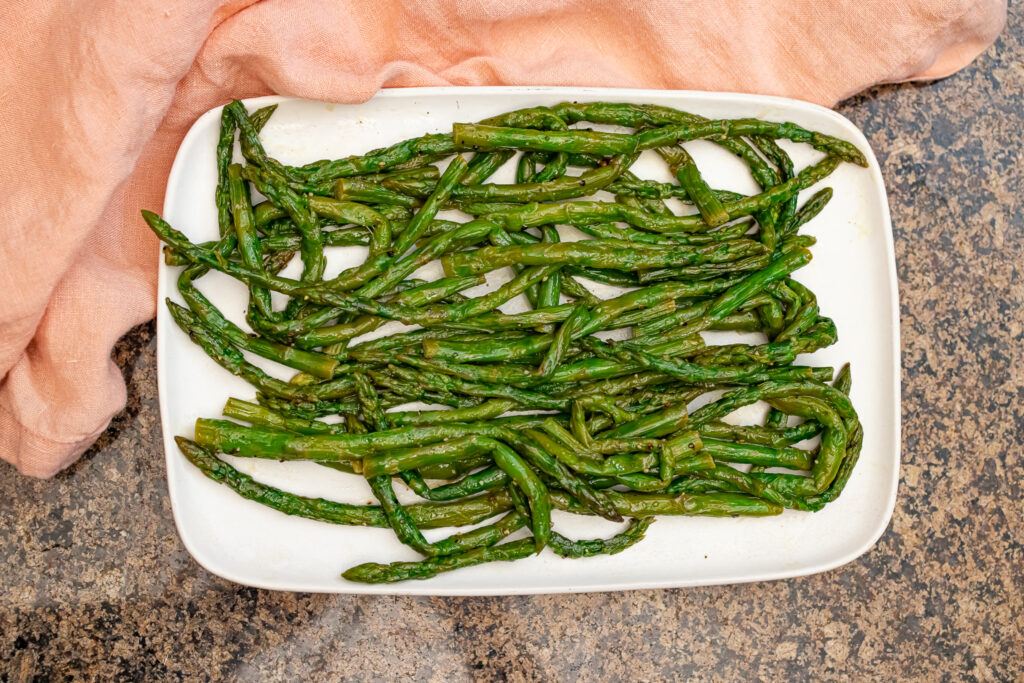
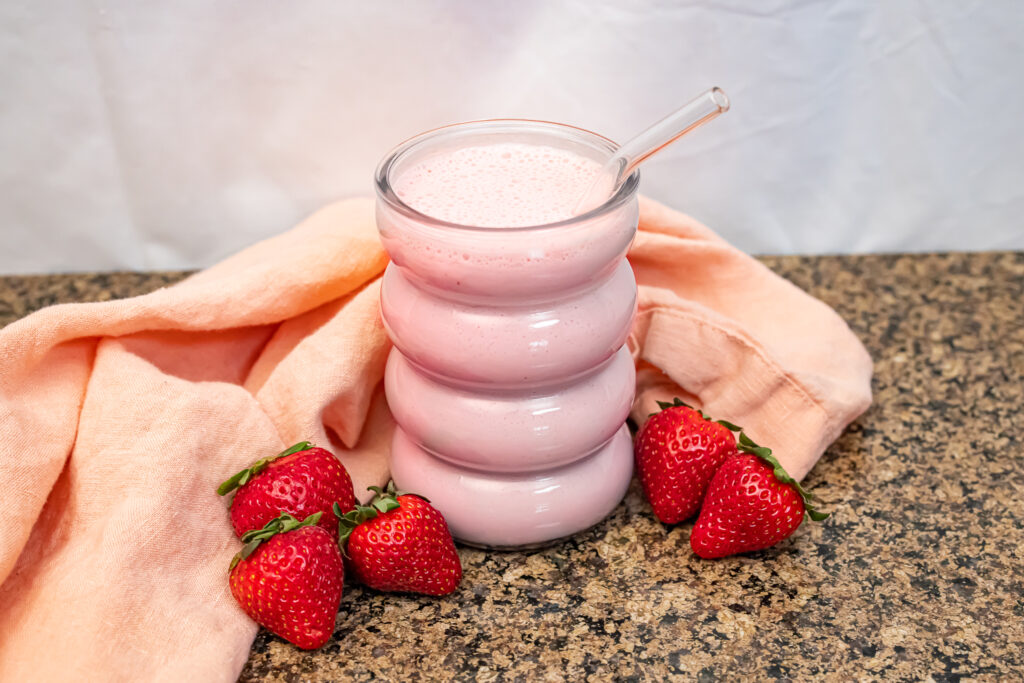
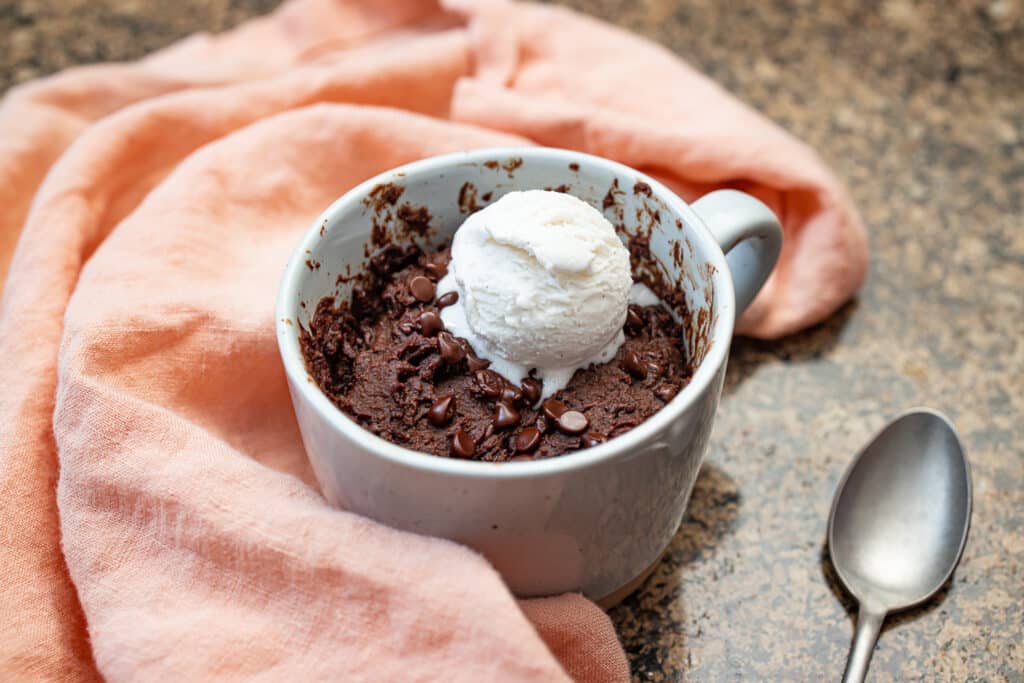
Leave a Reply